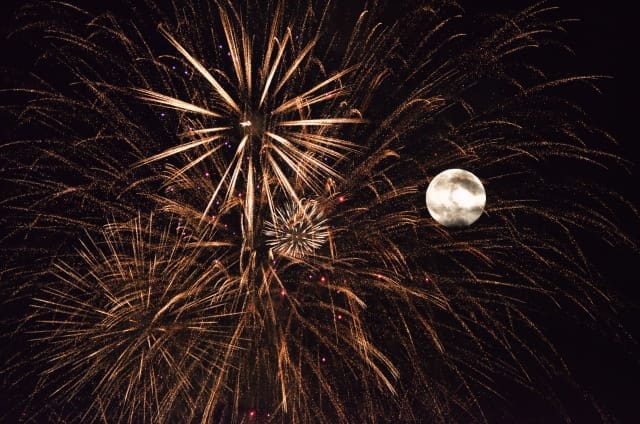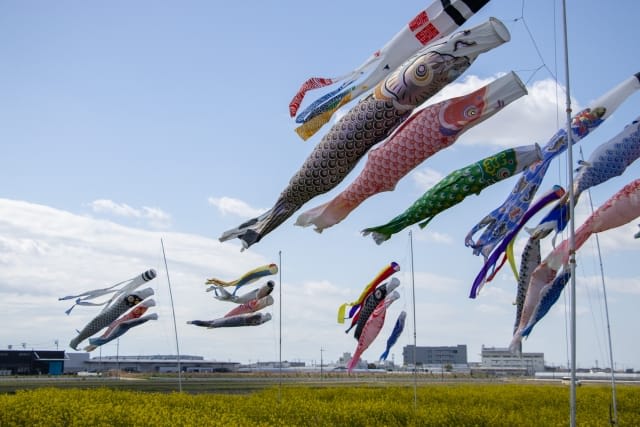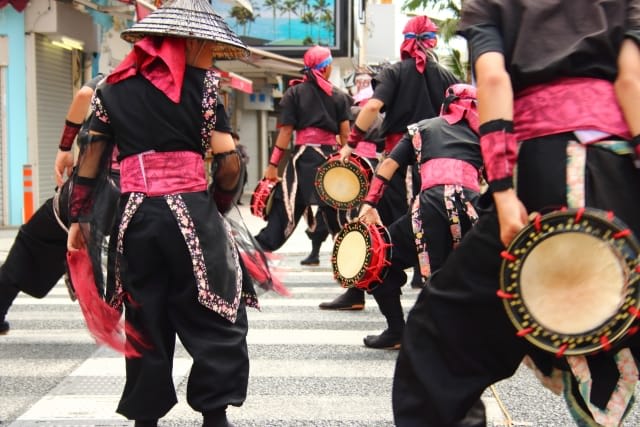Tokyo Seasons: A Year-Round Journey Through Japan's Capital
This time I wrote an article about Tokyo, a city I was born and raised. And I updated this article in January 2025 to incorporate my findings from this research, along with the latest information for 2025.
Another reason for updating the article is the growing interest in tours that allow visitors to safely and deeply experience Tokyo. Because Tokyo is a city that continues to develop at a dizzying pace and in complex ways, tourists visiting for the first time find it extremely difficult to discover the truly excellent spots beloved by locals.
This is why food tours led by knowledgeable local guides who know Tokyo inside and out have been gaining popularity, as they take visitors through Tokyo's maze of establishments.
In fact, Magical Trip's tour, which ranked #1 among all tours on Tripadvisor, has been receiving numerous applications.

If you want to experience authentic izakayas beloved by Shibuya locals, try the "Shibuya Bar Hopping Night Tour in Tokyo," which is ranked #2 on Magical Trip. A knowledgeable local guide who knows Shibuya inside and out will take you to spots where you can enjoy genuine Japanese cuisine.
And if you want to make the most of Tokyo's nightlife, you absolutely must join the "Tokyo Bar Hopping Night Tour in Shinjuku," which is rated #1 on Tripadvisor. You can safely explore Shinjuku's historic retro drinking districts and Kabukicho, the largest entertainment district in Asia, with an expert guide who knows Shinjuku thoroughly.
We hope you'll have a wonderful time experiencing everything Tokyo has to offer by joining a Magical Trip tour!
Introduction
Tokyo is a city that attracts attention from all over the world as the capital of Japan.
I've been living in this city for over 30 years and can feel its diverse charms every day. What has been particularly impressive is the way Tokyo changes its appearance with each season. The unique atmosphere and experiences that each season brings further deepen the appeal of this metropolis.
In spring, cherry blossoms paint the city in a gentle pink, while in summer, lively festivals and fireworks displays color the night sky. When autumn arrives, the fall foliage brings beauty to the urban hustle and bustle, and in winter, dazzling illuminations transform the city into a fantastical world.
And with these seasonal changes, Tokyo's culinary experiences and cultural events also shift. Even now that I've moved to Osaka, I vividly remember the cherry blossom viewing in Ueno Park, the fireworks display over the Sumida River, the autumn foliage viewing at Mt. Takao, and the bustling New Year's visits to shrines.
In this article, I'll introduce you to the charms of each season in Tokyo, drawing from my own experiences. Let's discover the multifaceted appeal of Tokyo through its seasons together!
Table of Contents
・Characteristics of Tokyo's Seasons
・Which Season is Most Recommended in Tokyo?
・Tokyo in Spring (March to May)
・Tokyo in Summer (June to August)
・Tokyo in Autumn (September to November)
・Tokyo in Winter (December to February)
・Precautions for Enjoying Tokyo's Seasons
Characteristics of Tokyo's Seasons
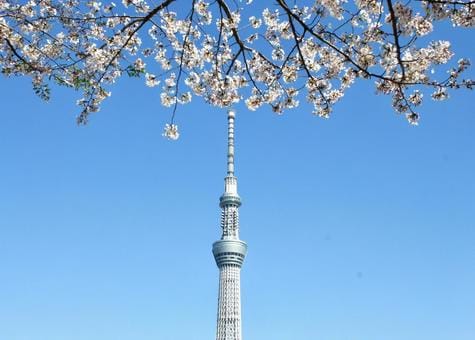
Each season in Tokyo has its own unique charm. I look forward to feeling the change of seasons on my skin more than anything else.
Tokyo's spring is world-famous for its cherry blossom season. The sight of the entire city enveloped in a pale pink color, with people gathering in parks and along riverbanks to enjoy flower viewing, is one of the symbols of Tokyo's culture. I look forward to cherry blossom viewing with my friends in Ueno Park every year.
When summer arrives, Tokyo is filled with energy. The fireworks displays that color the night sky are an essential part of summer scenery. In particular, I was overwhelmed by the power of the Sumida River Fireworks Festival every year. The festivals held in various areas are also an excellent opportunity to experience traditional Japanese culture.
Autumn is the season of fall foliage. Even among the skyscrapers in the city center, you can find trees with vibrant colors. My favorite was autumn leaf viewing at Mt. Takao. The experience of being surrounded by natural beauty just a short distance from the city center is exceptional.
In winter, the city is decorated with illuminations. The illuminations in Marunouchi and Roppongi, in particular, create a wonderful spectacle that combines urban sophistication with a fantastical atmosphere. Also, shrines and temples bustling with New Year's visitors at the end and beginning of the year are special places where you can feel Tokyo's traditional culture.
Tokyo's food culture also changes significantly with the seasons. You can enjoy dishes using seasonal ingredients such as bamboo shoots in spring, eel in summer, matsutake mushrooms in autumn, and oysters in winter. I especially love the aroma of matsutake mushrooms, an autumn delicacy, and look forward to it every year.
The seasons in Tokyo have a unique charm that interweaves city and nature, tradition and modernity. By experiencing the events and food culture suited to each season, you can gain a deeper understanding of Tokyo's culture.
Which Season is Most Recommended in Tokyo?

If I had to choose the best season to visit Tokyo, I would recommend spring without hesitation. Especially from late March to early April, you can enjoy Tokyo's charms to the fullest.
Spring in Tokyo is most spectacular for its cherry blossom season. The entire city is dyed in a pale pink color, giving you a sense of stepping into a different world. What I particularly loved was cherry blossom viewing in Ueno Park. The sight of about 1,200 cherry trees in full bloom is indescribably beautiful.
Moreover, spring has a mild and comfortable climate. The temperature is neither too cold nor too hot, making it ideal for walking around the city or enjoying outdoor activities. I often enjoyed walking through the beautiful fresh greenery of the Meiji Shrine forest or jogging in the Imperial Palace Outer Gardens.
However, there are a few things to keep in mind when enjoying spring in Tokyo. First, the cherry blossom season attracts many tourists, and popular spots can be very crowded. I recommend visiting on weekdays rather than weekends. Also, it's important to dress in layers that can be easily adjusted, as the temperature can fluctuate significantly.
Tokyo in Spring (March to May)
When is the Best Time to See Cherry Blossoms in Tokyo?
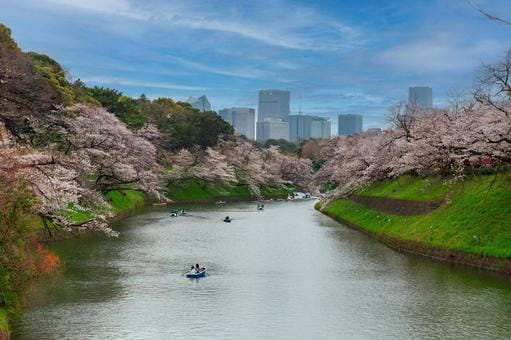
The cherry blossom season in Tokyo is a special time I look forward to every year. Usually, the most beautiful period is from late March to early April. However, this magical period typically lasts only about a week, which is one of its characteristics.
The blooming time of cherry blossoms can vary slightly from year to year. It's difficult to predict the exact timing as it depends on temperature and weather conditions. Therefore, I recommend checking the blooming status regularly on official websites of various spots or Japanese weather forecast sites from around March.
Every year, I look forward to predicting the cherry blossom bloom with my friends. It's our annual tradition to make predictions like "Will it be early this year, or late?" while watching Tokyo's weather forecast. And when we finally receive news of the blossoms opening, we rush to make our flower-viewing plans.
Also, the blooming time differs depending on the type of cherry blossoms. For example, early-blooming Kawazu cherry blossoms start to bloom from late February to early March, while late-blooming Yaezakura can be enjoyed until mid-April. Knowing these varietal differences allows you to enjoy cherry blossoms for a longer period.
I start checking cherry blossom information from late October every year to make sure I don't miss the best viewing time.
Cherry Blossom Spots in Tokyo
Ueno Park

Ueno Park is a cherry blossom spot I visit without fail every year. The sight of about 1,200 cherry trees in full bloom is truly breathtaking. Especially the cherry tree-lined main street becomes like a tunnel of cherry blossoms when in full bloom, and its beauty is so stunning that I often find myself stopping in my tracks.
The charm of Ueno Park is not just the cherry blossoms. There are cultural facilities such as Ueno Zoo and the National Museum of Western Art in the surrounding area, which can be enjoyed along with cherry blossom viewing. It's my annual tradition to view a special exhibition at the Ueno Royal Museum after enjoying cherry blossoms with friends.
Night cherry blossom viewing is another attraction of Ueno Park. The cherry blossoms illuminated at night create a fantastical atmosphere different from daytime. I liked to stop by on my way home from work and relax from the day's fatigue while looking up at the night cherry blossoms.
The best time to see cherry blossoms in Ueno Park is usually from late March to early April.
Also, food stalls and vendors are part of the enjoyment of cherry blossom viewing in Ueno Park. You can experience the atmosphere of Tokyo festivals with yakitori, takoyaki, cotton candy, and more.
Ueno Park is easily accessible, about a 5-minute walk from Ueno Station on the Tokyo Metro Ginza Line and Hibiya Line, and JR lines. While it gets crowded during the cherry blossom season, that's part of experiencing Japan's spring tradition.
Website: https://www.kensetsu.metro.tokyo.lg.jp/jimusho/toubuk/ueno/en_index.html
Meguro River
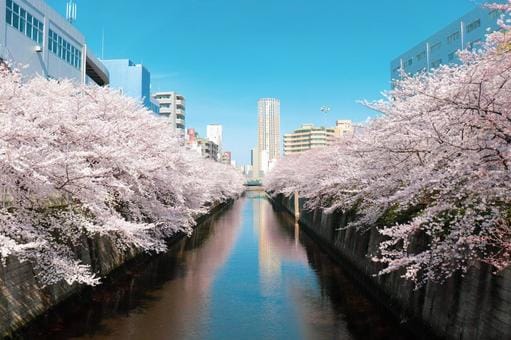
The cherry blossom-lined Meguro River is one of my favorite cherry blossom spots in Tokyo. The tunnel of cherry blossoms stretching for about 4 km is breathtaking. The beauty of the cherry blossoms blooming along the river creates a special space that makes you forget the hustle and bustle of the city.
What I particularly like is the time from evening to night. When the sun sets, the cherry blossoms along the river are illuminated, creating a fantastical atmosphere completely different from daytime.
Every spring, the "Meguro River Cherry Blossom Festival" is held. During this time, food stalls line up along the river, and it becomes crowded with many people.
As the Meguro River is characterized by its long cherry blossom-lined promenade, I recommend walking along the river rather than staying in one spot. I often used to walk from Nakameguro Station to Gotanda Station. The view of cherry blossoms from the bridges along the way is particularly beautiful and perfect for photography.
Access is very convenient, just a short walk from Nakameguro Station on the Tokyu Toyoko Line and Tokyo Metro Hibiya Line. There are also many unique cafes and restaurants around the station, so it's a good idea to stop by before or after viewing the cherry blossoms.
Spring Flavors
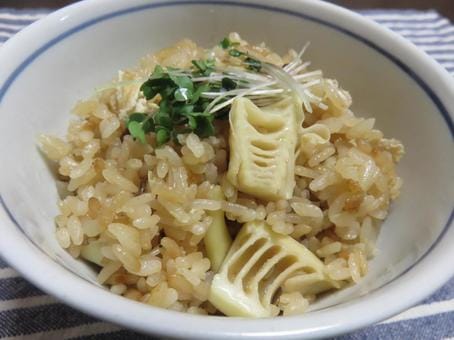
Spring in Tokyo is not only enjoyable for its sights but also for its rich flavors.
First, the representative taste of spring would definitely be bamboo shoots. What I particularly like is bamboo shoot rice. The fragrant aroma of bamboo shoots permeating the fluffy, freshly cooked rice lets you fully savor the scent of spring.
And spring Japanese sweets are not to be missed. Among them, sakura mochi is my favorite. It's a Japanese sweet where sweet bean paste is wrapped in dough made from domyoji or wheat flour, then wrapped in a salt-pickled cherry blossom leaf. The harmony of the cherry blossom scent, the texture of the mochi, and the sweetness of the bean paste is exquisite. Every year when the cherry blossom season arrives, I look forward to buying it from a long-established Japanese confectionery shop near my workplace.
Spring in Tokyo is a season to enjoy with both your eyes and your taste buds. Appreciating cherry blossoms while savoring spring flavors - I believe this is the best way to deeply experience Tokyo's spring. Please enjoy Tokyo's spring with all your senses.
Spring Events
Nezu Shrine Azalea Festival
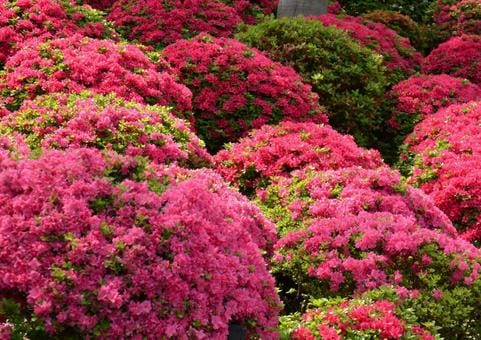
The Nezu Shrine Azalea Festival, held from mid-April to early May every year, is a wonderful opportunity to enjoy the vibrant colors of spring even after the cherry blossom season has ended.
I still vividly remember the excitement I felt when I first visited this festival. The sight of about 3,000 azalea plants blooming all over the shrine grounds was breathtaking.
The charm of the Azalea Festival is not just the flowers. Nezu Shrine itself is a historic shrine built in the early Edo period, and the harmony between its historical atmosphere and the vibrancy of the azaleas is spectacular.
Access is convenient, about a 5-minute walk from Nezu Station on the Tokyo Metro Chiyoda Line. It's also within walking distance from Ueno Park, so you can enjoy both Ueno's cherry blossoms and Nezu Shrine's azaleas in one day.
Website: https://nedujinja.or.jp/tsutsuji/
Sanja Matsuri (Asakusa Shrine)
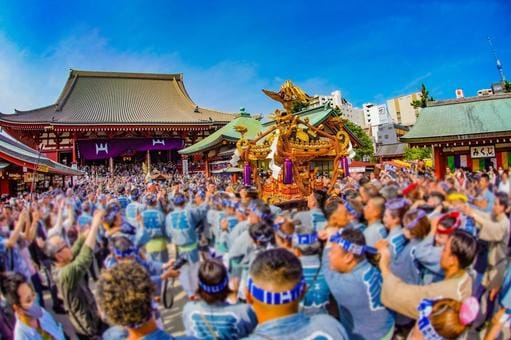
The Sanja Matsuri, held in mid-May every year, is known as one of the three great Edo festivals with about 700 years of history.
I still can't forget the excitement I felt when I first experienced the Sanja Matsuri. The sight of about 100 portable shrines parading through the town was overwhelming.
What was particularly impressive was the moment of the mikoshi (portable shrine) procession. The sight of the mikoshi departing from Asakusa Shrine and parading through the streets of Asakusa was like witnessing a scene from a historical drama. As photography is my hobby, I used to struggle every year to capture the best moments with my camera.
Access is very convenient, just a short walk from Asakusa Station on the Tokyo Metro Ginza Line or Toei Asakusa Line. Asakusa Station on the Tobu Skytree Line is also nearby.
Website: https://www.asakusajinja.jp/english/
Tokyo in Summer (June to August)
How Hot is Tokyo in Summer?
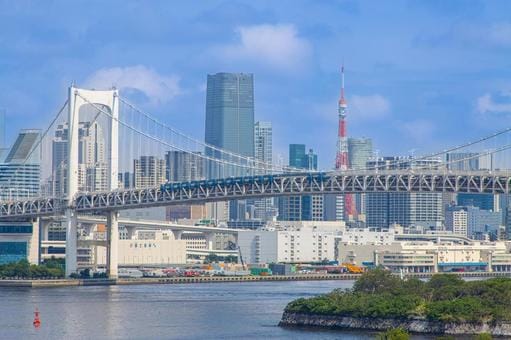
In a word, Tokyo's summer can be described as "hot." I still struggle with the summer heat every year. Especially from July to August, it's truly a scorching season.
It's not uncommon for temperatures to exceed 35 degrees Celsius (95°F) for days on end. In my experience, early August is particularly harsh, with sweat pouring down like a waterfall just from walking outside. However, the severity of Tokyo's summer isn't just about the temperature. The high humidity makes the perceived temperature even higher.
In this severe heat, taking precautions against heat stroke is very important. First, hydration is key. I always carry a water bottle and make sure to drink water frequently. Don't forget to replenish salt as well. My favorite was the salt candies sold at convenience stores.
Taking breaks is also important. When I went out, I made sure to rest frequently in cool places. Tokyo has convenience stores and cafes everywhere, so I often used these as my go-to spots for a quick break. Walking in the shade or using a parasol is also effective.
One of the tricks to surviving Tokyo's summer is to make good use of air-conditioned facilities. I often spent time in museums or libraries. It's a win-win situation where you can enjoy culture in a cool environment. Large commercial facilities are also good places to escape the heat.
While Tokyo's summer is certainly harsh, you can still enjoy it if you know how to cope. Rather, it's because of this heat that summer events like fireworks displays and festivals become even more attractive.
If you visit Tokyo in summer, make sure to prepare and take precautions, but also fully enjoy the unique pleasures of this season.
Fireworks Displays
Sumida River Fireworks Festival
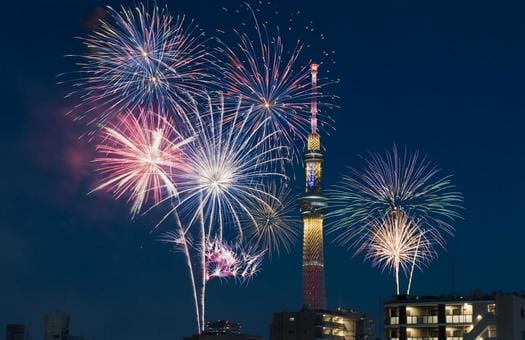
The Sumida River Fireworks Festival, held on the last Saturday of July every year, is an essential part of Tokyo's summer traditions.
The sight of about 20,000 fireworks coloring the night sky is truly spectacular.
I still vividly remember the excitement I felt when I first saw this fireworks festival. The size of the fireworks, the richness of colors, and the power of the launch were unlike anything I had experienced at other fireworks displays.
The charm of this fireworks festival isn't just the scale of the fireworks. It's a traditional fireworks display that has continued since the Edo period, and you can feel the weight of its history. Every year, through this fireworks festival, I feel the summer culture and traditions of Tokyo firsthand.
However, to enjoy this popular event, there are a few things to keep in mind. First, crowds are unavoidable. I used to go to the site from the afternoon every year to secure a spot early. Also, public transportation gets very crowded, so it's important to allow plenty of time for travel.
Website: https://www.sumidagawa-hanabi.com/
Jingu Gaien Fireworks Festival
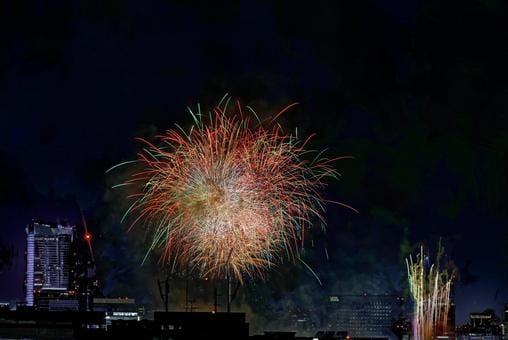
The Jingu Gaien Fireworks Festival is another wonderful fireworks display that colors Tokyo's summer. This event, held in mid-August, is known as a large-scale fireworks show that can be enjoyed in the heart of the city. This fireworks festival is one of my annual pleasures.
The charm of this fireworks festival, held at Meiji Jingu Gaien, lies primarily in its location. The fireworks launched in the middle of the city center create a fantastical scene against the backdrop of skyscrapers. When I first saw these fireworks, I was breathless with amazement at the fusion of the city night view and the fireworks.
What was particularly impressive was the moment when you could see the fireworks and Tokyo Tower at the same time. The scenery created by the red glow of Tokyo Tower and the colorful fireworks is truly a sight unique to Tokyo, and I struggled every year to capture it with my camera.
However, this fireworks festival is also very popular, so it's important to arrive early. I used to head to the site 3-4 hours before the start every year.
Website: https://www.jinguhanabi.com/
Summer Flavors
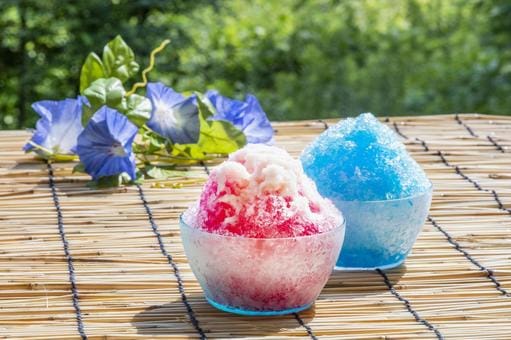
Tokyo's summer is attractive not only for its heat but also for its seasonal flavors.
First, you can't miss shaved ice. When you experience Tokyo's summer heat, the appeal of shaved ice doubles. I particularly like the matcha flavor, where the rich matcha syrup and mildly sweet red beans instantly soothe my body tired from the heat.
Recently, there has been an increase in specialty shops offering various flavors and innovative toppings. Shaved ice with plenty of fruits like mango or strawberry is beautiful to look at and highly recommended.
Another essential is cold Chinese noodles. This dish, where you eat cold noodles with a special sauce, is perfect for a hot day's lunch. You can easily buy it at convenience stores, so please give it a try.
Summer Events
Fukagawa Hachiman Festival
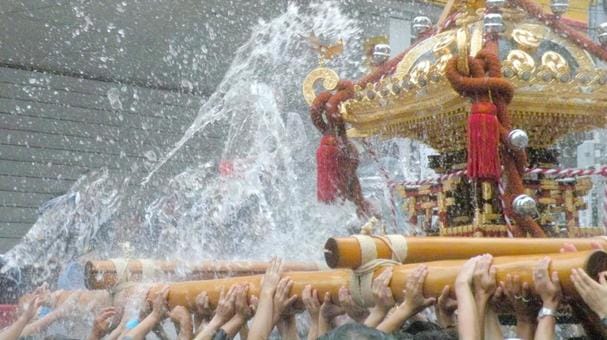
This festival, known for its grand festival held once every three years, is a traditional event that has continued since the Edo period. The next grand festival is scheduled for 2025 and will be one of the events that will enliven Tokyo's summer the most that year.
I first experienced this festival when I was a university student. The excitement and emotion I felt then are still vivid in my memory.
What was particularly impressive was the unique custom called the "Water Throwing Festival." As 53 large portable shrines parade through the town, people along the route throw water on the shrines and their bearers. The sight of people carrying the shrines while being doused with cold water under the midsummer sun was the essence of a summer festival.
While many people are looking forward to the grand festival in 2025, even in years without the grand festival, the annual festival held in August is still plenty enjoyable. Please take this opportunity to fully experience the charm of Tokyo's traditional summer festival.
Website: http://www.tomiokahachimangu.or.jp/annai/maturi/maturih1.html
Koenji Awa Odori
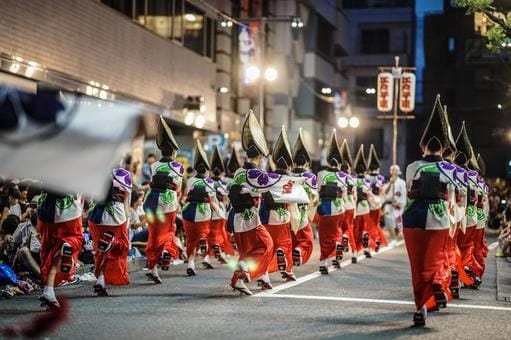
The Koenji Awa Odori is one of the events that most colorfully adorns Tokyo's summer. It is held on the last Saturday and Sunday of August every year.
Awa Odori is a traditional Bon dance from Tokushima Prefecture, characterized by its unique rhythm and dance. You might wonder why this Awa Odori is held in Koenji, Tokyo.
In fact, this festival started in 1957 with the aim of revitalizing the local shopping district. Since then, it has expanded in scale year by year, and now it has become one of the largest Awa Odori events in Japan.
The greatest charm of Koenji Awa Odori is its scale and energy. About 10,000 dancers participate, and the entire Koenji area becomes a dance stage.
The costumes of the dancers are also a highlight. The street is colored with vibrant yukata and happi coats, and uniquely shaped hats. Especially, the gorgeous costumes and elegant dances of the female dancers are captivating.
If you have a chance to visit Tokyo, please experience the Koenji Awa Odori. Whether you brave the crowds to visit popular spots or enjoy the New Year at a small local shrine near your hotel, you're sure to feel the traditions and culture of Tokyo's New Year firsthand.
Website: https://www.koenji-awaodori.com/language/eng.html
Tokyo in Autumn (September to November)
When is the Best Time to See Autumn Foliage in Tokyo?
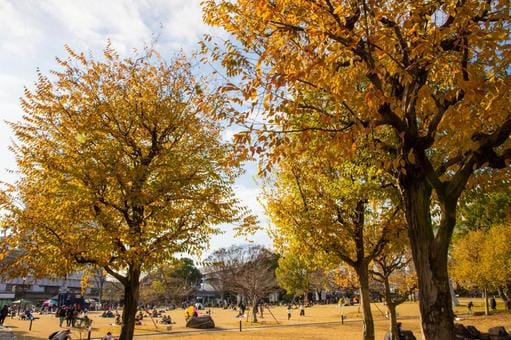
The autumn foliage in Tokyo is one of the seasonal landscapes I look forward to the most after spring.
The best time to see autumn foliage in Tokyo is typically from late November to early December. During this time, Tokyo's streets are adorned in autumn colors, completely transforming the cityscape. When this season arrives, it's my tradition to visit different autumn foliage spots every weekend.
Compared to the cherry blossom season, the peak period for autumn foliage is relatively longer. Usually, you can enjoy beautiful autumn leaves for about two weeks.
This is because there are various types of trees that change color, and each tree changes color at slightly different times. For example, ginkgo trees shine golden, while maple trees turn a vivid red. Enjoying this gradation of color changes is one of the pleasures of autumn leaf viewing.
However, it's important to be mindful of the weather. Bad weather, especially strong wind and rain, can cause leaves to fall all at once. I once had a much-anticipated autumn leaf viewing ruined by heavy rain. Therefore, I recommend checking the weather forecast frequently and aiming for a period of good weather.
Also, the best time for autumn foliage can vary slightly from year to year. The timing of color change depends on that year's temperature and precipitation. Therefore, it's important to check the latest autumn foliage information on official websites of each spot or tourism information sites before visiting.
I used to start checking autumn foliage information from late October every year to make sure I didn't miss the best viewing time.
Autumn Foliage Spots in Tokyo
Shinjuku Gyoen
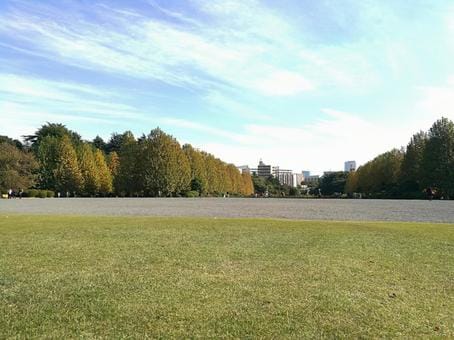
Shinjuku Gyoen is a special place where you can quietly enjoy autumn foliage in a vast Japanese garden, despite being in the center of Tokyo.
The autumn foliage at Shinjuku Gyoen reaches its peak from mid-November to early December. One of the features of this spot is that you can enjoy the autumn colors of various tree species, including ginkgo, maple, and zelkova.
Another charm of Shinjuku Gyoen is its vastness and tranquility. Within the extensive grounds of 58.3 hectares, various styles of gardens coexist, including Japanese gardens, French formal gardens, and English landscape gardens. My favorite is the Japanese garden, where the combination of autumn leaves and the pond creates a scene that embodies the essence of Japanese autumn.
Also, the appeal of Shinjuku Gyoen is that you can quietly enjoy autumn foliage despite being in the city center. The sight of colorful autumn leaves spreading against the backdrop of skyscrapers is a uniquely Tokyo landscape that makes you feel the harmony between the city and nature. I often stop by here on my way home from work to slowly enjoy the autumn leaves away from the hustle and bustle.
Website: https://www.env.go.jp/garden/shinjukugyoen/english/index.html
Mt. Takao

Mt. Takao is a mountain famous for its autumn foliage, accessible by train in about an hour from central Tokyo.
Every autumn, I look forward to climbing Mt. Takao with my friends. Mt. Takao, where you can enjoy autumn foliage surrounded by rich nature away from the urban hustle and bustle, can be said to be one of the representative places of Tokyo's autumn.
The autumn foliage at Mt. Takao reaches its peak from mid-November to early December. One of its features is that you can enjoy the gradually changing colors of the trees as you climb towards the 599-meter summit.
When I visited, what was particularly impressive was the view of the autumn foliage from the cable car and lift. The colorful trees spreading below were very moving.
The view from the summit is also exceptional. On clear days, you can see Mt. Fuji in the distance. The scenery of the majestic Mt. Fuji against the backdrop of mountains colored with autumn leaves can truly be called spectacular.
Also, Mt. Takao has numerous hiking courses. It's important to choose an appropriate course based on your physical strength and time. For first-timers, it might be a good idea to use the cable car or lift. When I visited Mt. Takao for the first time, I used the cable car.
Autumn Flavors
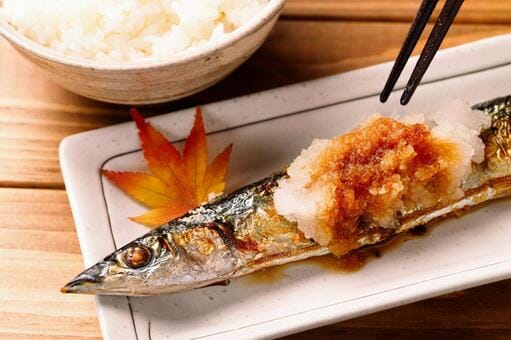
Autumn in Tokyo is not only a season for enjoying the autumn foliage but also a season of rich flavors.
First, the representative taste of autumn would definitely be Pacific saury (sanma). Sanma carefully grilled over charcoal is crispy on the outside and fluffy on the inside, and its savory aroma makes you feel the arrival of autumn. Since sanma is fatty, I recommend eating it with a squeeze of lemon for a refreshing taste.
Next, matsutake mushrooms, known as a luxury ingredient, can also be called the king of autumn flavors. Its unique aroma and texture have captivated many Japanese people. While it's a luxury ingredient, matsutake rice is especially delicious.
Chestnuts are also an essential autumn flavor. In Tokyo, various chestnut-based sweets appear. Not only traditional Japanese sweets but also Western-style sweets like Mont Blanc are popular, and there are always long lines at the autumn events in department stores.
Autumn Events
Tori no Ichi at Asakusa Shrine
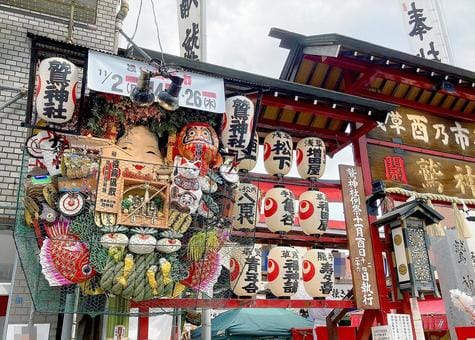
Tori no Ichi at Asakusa Shrine is one of the traditional festivals that represent Tokyo's autumn. This festival, held three times on the Days of the Rooster in November, is a traditional event that has continued since the Edo period, and you can't help but be fascinated by its history and lively atmosphere.
The main feature of Tori no Ichi is the bustle of people buying "kumade," a lucky charm. Kumade is a decorative rake adorned with various lucky charms, meant to rake in good fortune for the year and pray for prosperity in the coming year.
I also look forward to buying a small kumade and displaying it at home every year.
The festival venue extends from the grounds of Asakusa Shrine to Nakamise Street, bustling with crowds until late at night.
What I particularly like is the atmosphere of Asakusa at night. Walking down Nakamise Street illuminated by lanterns feels like you've slipped back in time to the Edo period. The sight of the shrine grounds lit by red lanterns and the lively scene of people seeking kumade is a rare sight in modern Tokyo.
Website: https://torinoichi.jp/
Ikebukuro Halloween Cosplay Festival

The Ikebukuro Halloween Cosplay Festival is a relatively new event that colors Tokyo's autumn, but its scale and excitement are astonishing. This event, held in late October every year, has been growing year by year since I lived in Tokyo, and has now become one of Tokyo's autumn traditions.
The main feature of this event is that cosplayers from the general public parade through the streets. The entire area around Ikebukuro Station, including large commercial facilities and parks, becomes a stage for cosplay.
When I first saw this event, I was overwhelmed by its scale and the enthusiasm of the participants. The streets overflow with a colorful array of costumes, from anime and game characters to movie heroes, and even original creative costumes.
The cosplay culture, the world of anime and games, and the extraordinary atmosphere created by the entire city coming together offer a special experience that can't be found anywhere else.
Website: https://ikebukurocosplay.jp/
Tokyo in Winter (December to February)
How Cold is Tokyo in Winter?
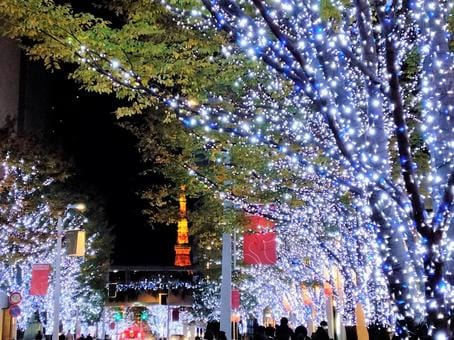
Winter in Tokyo isn't as harsh as many people imagine, but it's still a season where you can feel the cold sufficiently. From my experience of living in Tokyo for over 30 years, let me share the characteristics of Tokyo's winter.
The peak of Tokyo's winter is from December to February, which is when it gets coldest. The average temperature ranges from 5 to 10 degrees Celsius (41 to 50°F). This is slightly higher compared to winter temperatures in cities like London or Paris, but due to high humidity and often strong winds, the perceived temperature can feel even lower.
I particularly feel the cold from late January to early February. The chill in the mornings and evenings is especially severe, and I realize the arrival of winter when I see my breath turn white during my commute.
One of the characteristics of Tokyo's winter is that there are many sunny days. Days with clear blue skies often continue, and the sunlight feels warm during the daytime. I often use these sunny winter days to visit Tokyo's tourist spots on holidays. The views of Tokyo Tower and Tokyo Skytree in the clear air are exceptional.
On the other hand, snowfall is relatively rare, which is another feature of Tokyo's winter. While there are a few times a year when we experience heavy snow, it's not common for snow to accumulate otherwise.
There are many winter-specific enjoyments like illuminations, New Year's shrine visits, and warm hot pot dishes. With proper cold protection measures, you can fully enjoy the charms of Tokyo's winter.
Illumination Spots
Marunouchi Illumination
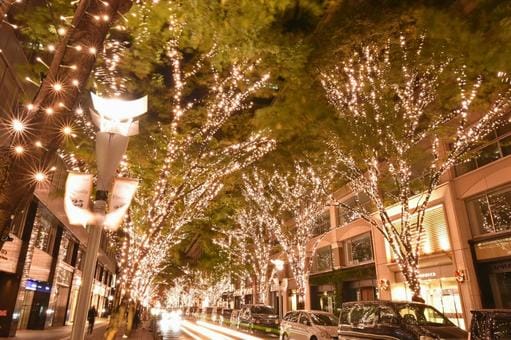
The Marunouchi Illumination is one of the events that most glamorously color Tokyo's winter.
The sight of the area around Tokyo Station being enveloped in light from about 1 million LED bulbs is breathtaking. This illumination, held from early November to mid-February, has become an indispensable part of Tokyo's winter scenery.
The charm of the Marunouchi Illumination isn't just the lit-up trees. The scenery created by the window lights of the surrounding skyscrapers and the illumination is a winter landscape unique to Tokyo, fusing urban sophistication with a fantastical atmosphere.
Access is very convenient, just a short walk from Tokyo Station on JR and Tokyo Metro lines.
Keyakizaka Winter Illumination
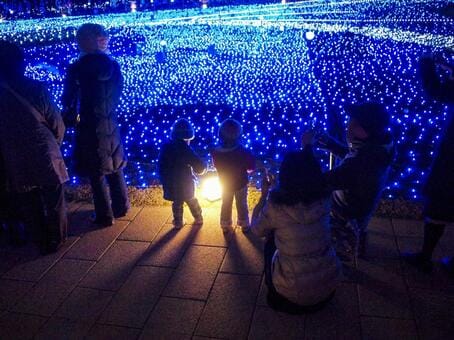
The Keyakizaka Winter Illumination is one of the most beautiful events that color Tokyo's winter.
The sight of the zelkova trees beautifully lit up along the approximately 400-meter tree-lined street of Keyakizaka Street in Roppongi Hills is breathtakingly beautiful. This illumination, held from December to around February, has become an indispensable part of Tokyo's winter scenery.
What's particularly impressive is the color scheme of the illumination. It's primarily unified in blue and white colors, and its sophisticated atmosphere exudes an elegance befitting the high-end area of Roppongi.
Access is very convenient, a 3-minute walk from Exit 1C of Roppongi Station on the Tokyo Metro Hibiya Line, or a 6-minute walk from Exit 3 of Roppongi Station on the Toei Oedo Line.
Winter Flavors
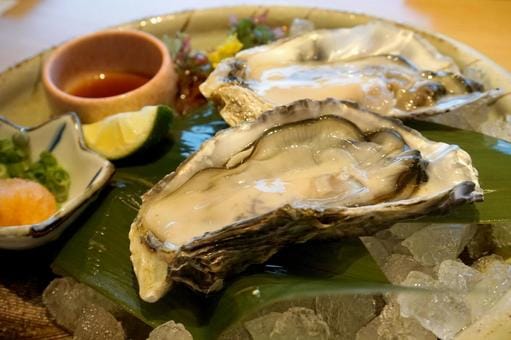
Winter in Tokyo is not only cold but also a season where you can enjoy rich flavors.
First, the representative taste of winter would definitely be oysters. There are various specialty shops in Tokyo where you can enjoy oyster dishes. My favorite is a long-established oyster specialty restaurant in Ginza.
You can enjoy oysters in various cooking methods, including raw, grilled, fried, and in hot pots. However, travelers should probably avoid raw oysters.
Next, hot pot dishes are essential. Gathering with friends around a hot pot on a cold winter night was one of my greatest pleasures. In Tokyo, you can enjoy various types of hot pot dishes. There are many types, including shabu-shabu, sukiyaki, and motsunabe.
You can also buy "oden," a type of food, at convenience stores, so please try it during your trip.
Winter Events
Hatsumode (First Shrine Visit of the New Year)
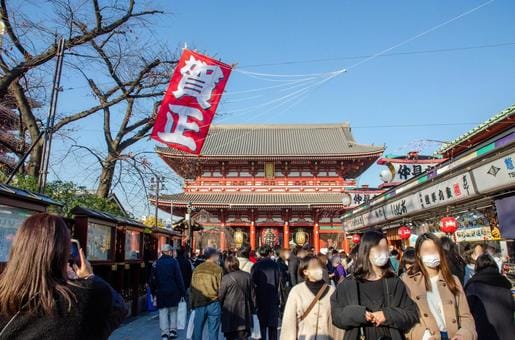
Hatsumode is one of the most important traditional events that color Tokyo's New Year. Visiting shrines and temples for the first time in the new year, starting from New Year's Day, is a special opportunity to put hopes and expectations into the new year.
While there are numerous shrines and temples in Tokyo, Meiji Shrine and Sensoji Temple are particularly popular spots for hatsumode. These places are bustling with millions of visitors from New Year's Eve to New Year's Day. I still vividly remember being overwhelmed by the number of people when I first went to Meiji Shrine for hatsumode.
Hatsumode at Sensoji Temple is even more lively. The hustle and bustle of Nakamise Street and the enthusiasm of people in front of the main hall mix to create an atmosphere like a festival.
During hatsumode, there's also a custom of drawing omikuji (fortune slips) and purchasing omamori (amulets). I used to look forward to drawing omikuji every year to predict my fortune for the year. The joy of getting "great fortune" was exceptional, and it made me feel like it would be a good start to the year.
Also, during hatsumode, many food stalls are set up, creating a festive atmosphere. You can enjoy Tokyo's festival staples like amazake, yakitori, and takoyaki.
If you have a chance to spend New Year's in Tokyo, please experience hatsumode. Whether you brave the crowds to visit popular spots or enjoy the New Year at a small local shrine near your hotel, you're sure to feel the traditions and culture of Tokyo's New Year firsthand.
Precautions for Enjoying Tokyo's Seasons
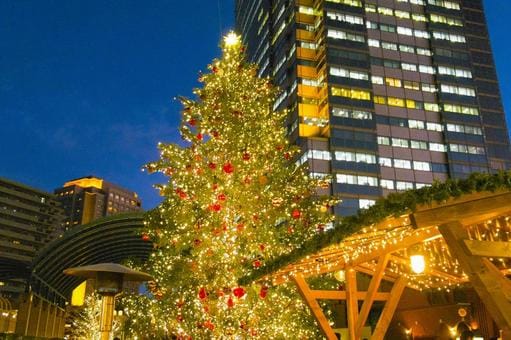
While each season in Tokyo is attractive and full of enjoyment, there are also points to be careful about. Let me share the seasonal precautions I've learned from living in Tokyo for many years.
First, it's important to be aware of the climate changes in each season and prepare appropriate clothing. Tokyo's climate is changeable, and especially in spring and autumn, there can be large temperature differences within a single day. I always make sure to carry a light jacket or cardigan.
Spring is the cherry blossom season and attracts many tourists, but cherry blossom viewing spots and popular areas can get very crowded. I always made sure to act early each year. For example, for cherry blossom viewing in Ueno Park, I recommend going on a weekday morning.
Summer is humid and can get very hot and muggy. What I'm particularly careful about is heat stroke. When going out, I use a hat or parasol and make sure to hydrate frequently.
Autumn is a relatively comfortable season, but popular spots can get crowded during the autumn foliage season. When visiting autumn foliage spots like Mt. Takao, it's important to plan ahead, such as departing early in the morning.
Winter is cold, but indoor spaces can be quite warm due to heating, so it's important to wear clothes that can be adjusted easily.
Lastly, during Japanese holidays and long vacation periods (Golden Week, Obon, year-end and New Year holidays, etc.), many tourist spots and commercial facilities get crowded, and it becomes difficult to make accommodation reservations. If you're visiting Tokyo during these periods, early planning and reservations are necessary.
Each season in Tokyo has its own unique charm, offering visitors various experiences. From the cherry blossoms in spring, fireworks festivals in summer, autumn foliage in fall, to illuminations in winter, the beautiful scenery and traditional events of each season add color to this metropolis.
No matter which season you visit, I hope this article helps you have a successful trip to Tokyo!

